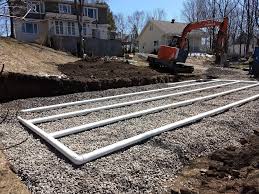How to Find Septic Tank Field Lines
Being the homeowner, it is your responsibility to know where the septic tank field lines or where the drain field is located. This is also necessary for the maintenance of the drain field. You can easily find the field lines by following some easy steps. In this article, we will discuss the location of the field lines, how to maintain them, the problems they might have and more.
So, how to find septic tank field lines? To find the septic tank field lines start the search from your home. Keep tracing the drain lines towards the septic tank. The septic tank will be installed at least 10-20 feet from the exterior. Since the tank is located just to the opposite side of the house, drain lines go to the leach field. Look at the naturally sloping land and you will be able to find the leach field.

Keep reading to know why you should know the location of septic tank field lines, the problems which can arise with these lines, costs of replacing these lines, and more.
CALL 855.925.0760 FOR SEPTIC SERVICES
How Do Septic Tank Field Lines Work?
The septic tank drainfield works in a simple process. The pipe gets waste from the septic tank. The perforated pipe then distributes this among the aggregate. It then trickles slowly through the aggregate. Next, the soil receives this effluent. Finally, in the last process, the soil filters out all harmful bacteria which is present in the waste. It is then returned to the water table.
Why Do You Need to Find Septic Tank Field Lines?
You should be aware of the location of septic tank field lines so that you can address the problems which might be there. You might have to call the professionals to check the field lines, and this is when you might have to find the field lines in case you do not know their location.
Problems in The Septic Tank Field Lines
On many occasions, it is seen that problems in the septic tank is due to a problem in the leach field. Here are some of the most common causes of the problem:
- Tree or plants cause damage to the pipes
- Damage due to passing of vehicles or due to construction on the leach field.
- Water runoff due to excessive snow or due to rainfall
- Draining of complex substances such as paint, grease, and chemicals through the drain.
CALL 855.925.0760 FOR SEPTIC SERVICES
Signs of Problems in Septic System
There can be several signs of a failing system. These can be gurgling sound in the plumbing, slow draining toilets, stinking odor inside your problem, consistent drainage backup, or the presence of bacteria in well water.
Strong Odors – If there is an unusually strong odor, there is a need to check this absorption field. If it is left untreated, the effluent can seep slowly in the surrounding soil. Gases from the decomposition process might reach the surface.
If there is a strong gas, it indicates the presence of a problem. The area where you will get the strongest odor, is the point where the problem lies. If you can determine this point, you will be able to see some signs.
Other Visual Signs – There are some identifiable signs of septic failure. These signs include patches of grass in unusual area. If you find that there is flourishing grass in a particular place, it is a sign of leakage in and around the area. It might also mean that there is an advanced failure in the system which might require expensive repairs.
How Can You Tell If Your Septic System is Failing or Might Fail?
Any homeowner should never try entering a septic tank, as it can lead to drowning and suffocation due to the presence of gasses trapped inside the tank. If there is a total failure of the system, it will have to replaced. Thus, a homeowner should be aware of the early signs which require inspection by professionals.
CALL 855.925.0760 FOR SEPTIC SERVICES
Clogging of Septic Field Lines
A drain field is designed in a way to let the liquid from the tank get absorbed in the ground. The solids usually dissolve, and they break down. Liquids tend to flow from the tank and through pipes to the drain field. Next, they exit and move into the ground. They move through holes in pipe. However, with time, this leach field might be clogged or damaged. This can happen because of buildup of material.
This can be a big problem as a full septic tank lets the sludge overflow. It moves to the drain field. A clogged drain field cannot be usually snaked out. It cannot be made clear like any drainpipe. In such a situation, steps have to be taken so that the problem is alleviated.
How to Maintain Your Septic Tank Field Lines
If you are aware about the location of the septic tank field lines, you have to ensure that it is properly maintained. This will ensure its proper functioning & the health & hygiene of your family.
- No one should be driving over the drain field and the septic tank.
- There are several homeowners who love to plant trees. However, these trees can be quite damaging for the drain field lines. Thus, ideally, they should not be planted around.
- You need to ensure that no extra water follows to the drain field. If there is excessive water going to the drain field, it can damage it over a period of time.
- You need to regularly maintain the drain field. Using a good pumper will ensure the presence of the right amount of moisture.
- In case of malfunctioning, there will be signs in the form of sewage backing up. The septic tank can be repaired.
Questions Related to Why You Need to Find Septic Tank Field Line
- How much will it cost to replace the septic field line?
The septic field lines are an integral part of the septic system. They play an important role in the transportation of waste water. In case there is a problem with the field line, and you have to replace it, you might have to pay an amount between $2000 – $10000.
- How deep are the septic field lines?
Usually a septic drainfield trench is between 18 inches to 30 inches in depth. As per USDA, the maximum soil cover over this disposal field is usually 2 feet to 5 feet in depth.
- Is it possible to repair the septic field lines?
Repairing septic field lines might not always be easy and quick. If there is a minor problem like clogging, it can be taken care of. However, if the problem is related to the bacterial mat, it might take a long time to repair the because the trench needs to be dry totally and this might take time.
- How long do the septic field lines last? Are they durable enough?
If these are maintained well, the field lines should last between 15 and 25 years. However, it is necessary to ensure that the field lines are properly preserved. This can begin with the monitoring of water which gets in the septic tank.
Your septic system and the drainfield is not as complicated as it seems to you. Knowing the location of the septic tank is necessary because you will have professionals coming for inspection and maintenance. You will not want to keep looking for the drainfield in their presence.
CALL 855.925.0760 FOR SEPTIC SERVICES
Sources:
https://septic-services-inc.com/2017/07/31/septic-drain-field-works/
https://www.felixseptic.com/leach-field-maintenance/
https://medium.com/waste-disposal-hub/how-septic-tanks-work-and-when-to-empty-them-346a4fe4fe6f










